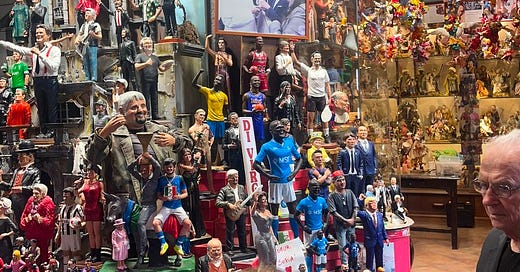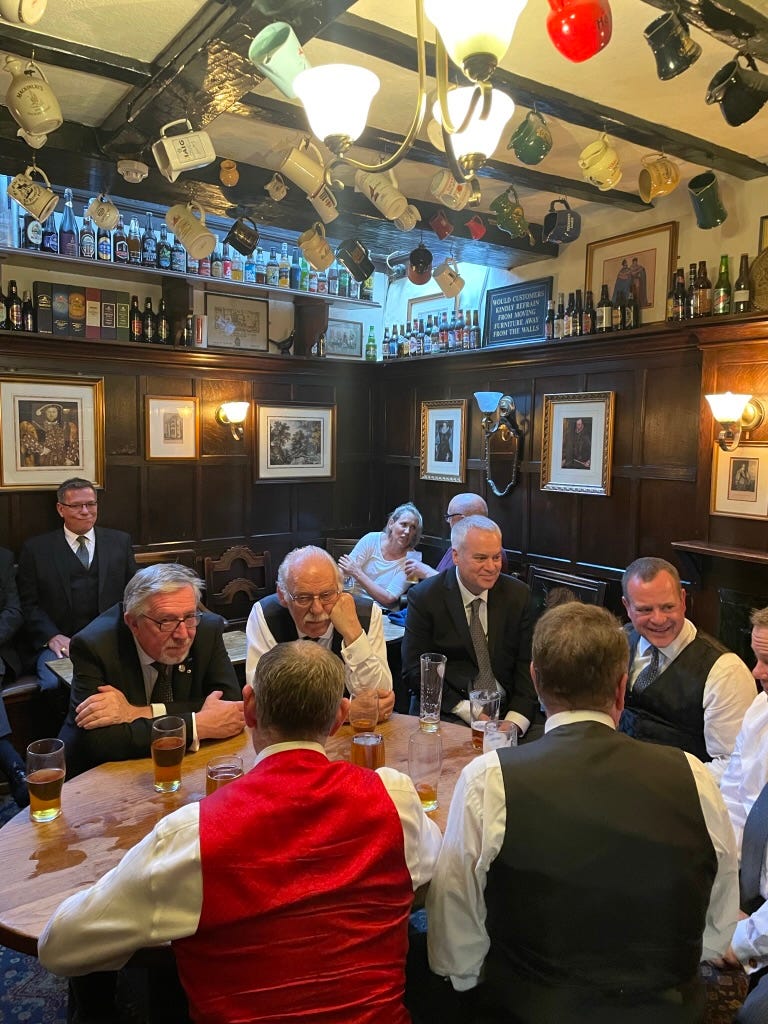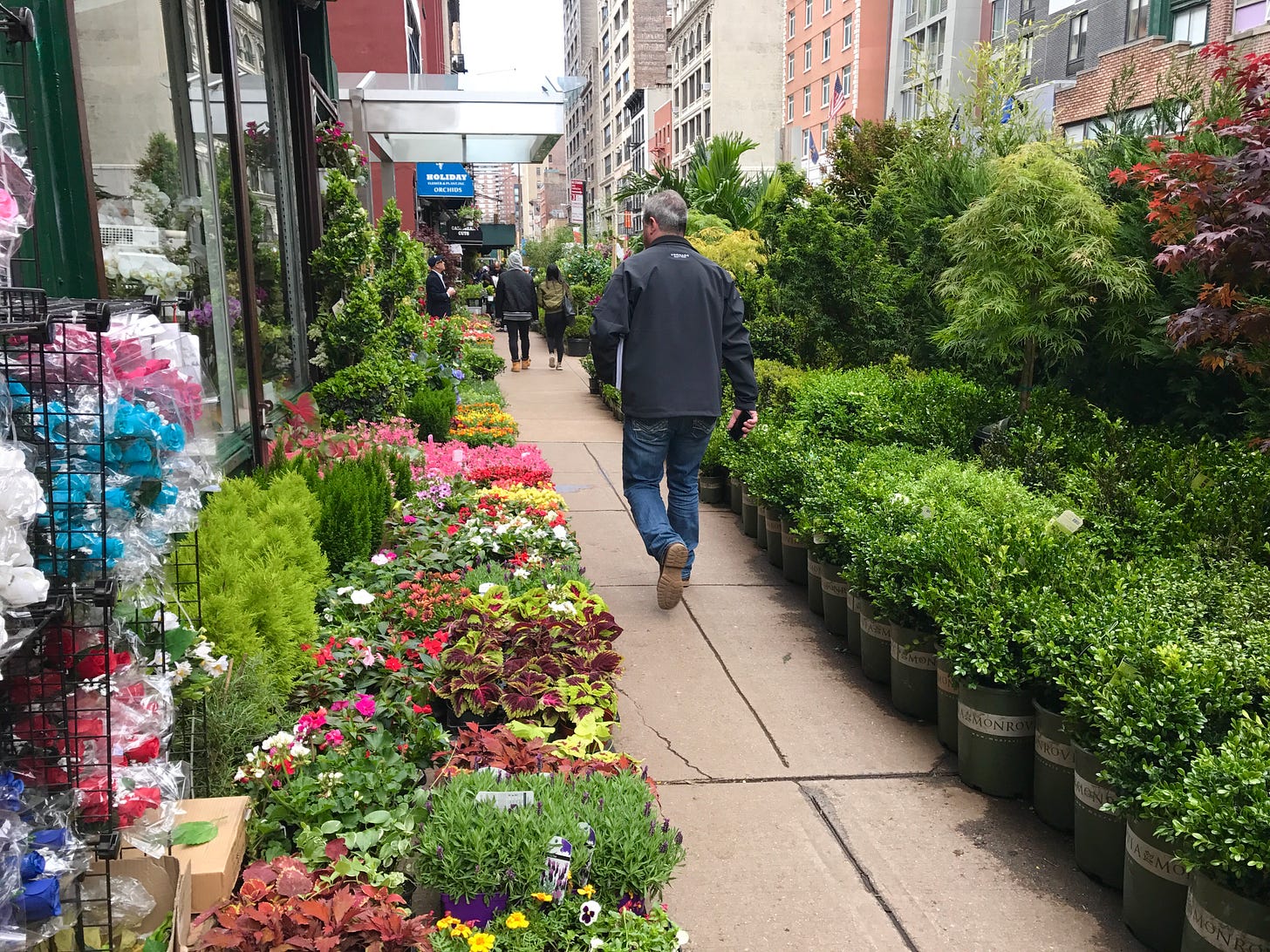One of the nice things about getting older is settling into your own skin and not stressing about what’s cool. This has spared me a lot of daily angst, but an unexpected perk has been a change in how I travel. When I’m in a new place I ignore anything with a whiff of trendiness. I’ve essentially become a millennial Rick Steves doing capital T- Tourist things. I no longer deny myself these pleasures because I’m worried about being seen rubbing shoulders with the fanny-pack set. I am the fanny pack set.
On my most recent trip, I carved out time in Naples to visit the Via San Gregorio Armeno, a narrow, tourist-choked street of storefronts and workshops. Historically these businesses specialized in crafting nativity scenes but now the area is essentially a bazaar for miniature, handmade plaster versions of anything in the world. Inside the stores and lining tables set on the street, you can find hundreds of different shapes of little bread loaves, every farm animal rendered at multiple scales, and probably every person/thing ever mentioned in the bible. On one street was a long table devoted to tiny pizzas, tiny pizza ovens, and, of course, tiny pizza chefs. A box in one shop was full of little vegetables, the brush strokes still visible on the cabbage leaves and carrot ends. The shops are full of tour groups, in fact, I suspect they exist now primarily because of tourists. I imagined this area springing from the workshops of the craftspeople who served Naples's many Baroque churches. Over time maybe they came to be renowned in the rest of Italy, then maybe in the rest of the Catholic world. Maybe migrants from Naples to America, or before them traders and merchants from the Kingdom of Naples, carried the reputation and goods of Via San Gregorio across the world to the point that it became a well-known attraction.
Nearly every big city has some sort of specialty district or street, some of which have been elevated to worldwide fame: Saville Row in London for suits or La Rue du Rhône in Geneva for watches. Each of these is the result of a unique tangle of economic, physical, and cultural factors, like mushrooms that only grow next to specific trees in certain weather. And yet, they speak to something universal about cities - as places that historically collected the artisans, tradespeople, and manufacturers of the region and were also home to a density of consumers that could support these industries.
One of the core ideas of urban economics is agglomeration - the advantages that come when many businesses cluster together. When lots of people bunch up it becomes easier for employers to find labor, infrastructure can be shared, ideas are more easily exchanged (or stolen), and supply chains become more efficient by serving a concentrated mass rather than a dispersed one. When nearby businesses engage in the same type of work you get specialization, and these clusters can obtain an almost gravitational pull on the world around them.
Here’s a dramatic example. A blue fin tuna caught off the coast of Cape Cod may be purchased on the dock by a Japanese buyer who flies it from the US to Tokyo on a freezer plane. The same fish will be sold at auction in a Tokyo market, butchered by specialty butchers, and flown by specialized air freight back to the USA to be eaten at a sushi counter in New York City not that far from where it was originally caught. If this sounds inefficient (and bad for the environment) it is, but there is also a logic to it. Tokyo has the butcher, the auctioneer, the buyer, and the fish-shipping logistics company all in one place. It has built up the physical and talent infrastructure of the fish trade to the point where it’s easier to buy a tuna that’s been flown across the world twice than get it at the dock yourself. Maybe most importantly, Tokyo has a culture of eating and obsessing over fish. This sounds obvious, but ultimately the driving reason for its success in the trade. Tokyo isn’t even a major fishing port, but its concentration of people who want fish, the cuisine value it places on certain high-quality fish, and the fact that it’s the biggest city in Japan with the most purchasing power combine to overcome the obstacles of its location. As Jane Jacobs says in The Economies of Cities: “Cities simply cannot be explained by their locations or other given resources. Their existence as cities and the sources of their growth lie within themselves.”
While business clusters spring organically from quirks of geography or culture, they are often highly manipulated. All governments engage in “economic development” and will use their powers to support certain industries, and businesses themselves will use their influence to secure favored conditions. For decades, New York has supported a relatively robust film industry. In the 1920’s the nascent industry drew heavily from the city’s existing theater talent and the set houses and rehearsal spaces that served Broadway. Huge movie studios were built in Queens and many related businesses — set building studios, prop houses, lighting companies, etc — were established nearby to work on films for the Marx Brothers and Paramount. During the 2000s, the city made a concerted effort to become a film capital. A robust list of tax incentives was created, the City sponsored job-training programs to prepare a legion of crew, and public land on the old industrial waterfront was leased at low cost to film and production companies for studios. All of this was done with public money in the form of direct subsidies and tax breaks. For a while, it worked. Film crews are large and many production jobs are unionized. New York was also cool, which meant people wanted to watch things about it. It was the height of our hipster glow. There was a time when I felt like I couldn’t walk through some neighborhoods without a sweaty PA in a beanie asking me to cross the street so I wouldn’t waltz into the background of some Lena Dunham project. If Girls wasn’t your thing (it is definitely my thing), you could flip to Broad City, Master of None, or High Maintenance. And yet, for all the effort, the industry employed about 185,000 people in 2019, which is slightly less than people who worked in nail salons (193,100) according to the NYS Comptroller. Worse, the film industry has been steadily evaporating since the pandemic, driven out by high costs, strikes, and maybe most importantly the willingness of cities like Atlanta to offer studios an even sweeter deal. This last point is crucial. Cities expend massive amounts of public money trying to win over firms and businesses that are mobile. In a globalized economy, there is very little keeping an industry in one place unless it needs access to very specific inputs. A recent article in The City said NYC is now fighting with London and Eastern Europe as studios work internationally to cut costs. While there are economic planners who want cities to rethink the amount they spend trying to coax fickle businesses to stay, I wouldn’t expect this kind of incentive race to end anytime soon. New York State recently increased the value of its tax credits for film production to $700 million dollars, and Mayor Eric Adams has stuck to his commitment to double the amount of studio space in the city. I’m not smart enough to say if this is “good” or “bad.” In employment, purchasing, and also by making New York culturally relevant our film industry confers many benefits, but at some point, you wonder if the juice is worth the squeeze.
Let’s retreat from urban economic theory for a second… these places are fun to visit! You can tell a lot about a city by what kind of specialty districts it supports, and going to a place where everyone is engaged in one, very specific business can feel like getting a peek into another world. When I lived in London I actually enjoyed walking around Temple - the cluster of law offices concentrated around the Temple Church. I liked watching lawyers in their ridiculous powdered wigs hustle between their cloistered chambers and the massive gothic court, and in the evening there would be packs of them crammed into the medieval pubs, gossiping, celebrating with clients, or strategizing for the next day’s session. It was a glimpse into a way of life that I wouldn’t normally have access to.
Maybe gazing at groups of lawyers isn’t your thing. I like to break specialized clusters into two categories: those you can just look at, and those you can shop at. You, as a casual visitor to NYC’s financial district with its cluster of banks and trading offices, can’t do much once you’ve rubbed the balls of the Wall Street Bull. Better to go uptown to West 28th Street early in the morning to the flower market, a strip of wholesale and specialty flower shops. Early in the morning, the fragrant street is bustling with wedding planners, stylists, and restaurant managers. As the clientele suggests, the district originally sprung up to serve the displays of the nearby large department stores and restaurants. It has been sustained (although it has shrunk) by the many venues and events that continue to take place in the City. In an era when most urbanites seem like they’re either a delivery worker or in some shade of tech/finance/marketing/media, it’s interesting to see actual tradespeople at work and engage even briefly with their world even if it’s just to buy a bouquet.










I used to wander the flower district just for the lovely sights and smells.
(Btw, "peak" should be "peek.")
Loved this wide-ranging post, and so glad you got around to the Flower District, which is the first thing I thought of. Also from my childhood in New York, with some remnants remaining: Garment District, Diamond District, and West 48th Street's Music Row. And best of all, Fourth Avenue was filled with used bookstores. Thanks for your observations about places like this!